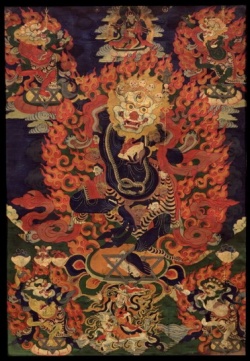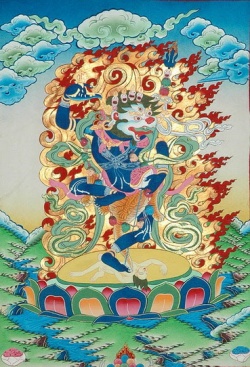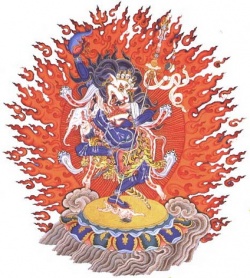Original scriptural source for Simhamukha
According to Dilgo Khyentse Rinpoche, the original scriptural source for Simhamukha is the Drwa-ba’i sdom-pa’i rgyud. This Tantra, where Simhamukha is linked with the eight wrathful Gauris (ke’u-ri-ma brgyad) and the eight Tramenmas or animal-headed sorceresses (phra-men-ma brgyad), appears to be connected with the Guhyagarbha Mayajala cycle (sGyu-‘phrul drwa-ba). In the “Tibetan Book of the Dead” (Bar-do thos grol), these Gauri witches, representing the eight types of mundane consciousness, and these eight animal-headed sorceresses, representing the eight objects of consciousness, appear to the deceased consciousness on the twelfth and thirteenth days of the Bardo experience after death.
However, it is mainly through the Termas or hidden treasure texts discovered since the 11th century that Simhamukha is practiced among the Nyingmapas. According to the Sutra system, the practitioner takes refuge in the Three Jewels of the Buddha, the Dharma, and the Sangha. However, according the Tantra system one also takes refuge in the Three Root of the Guru, the Deity, and the Dakini (bla-ma yi-dam mkha’-‘gro gsum). In the Terma system of Jatson Nyingpo (‘Ja’-tshon snying-po, 1585-1656), known as the dKon-mchog spyi ‘dus, “The Union of all the Precious Ones,” the principal visualization practice is the Zhi drag seng gsum.
Here zhi (zhi-ba) means “peaceful,” that is, the peaceful form of Guru Padmasambhava known as Guru Zhiwa, dressed in his usual robes, holding in his right hand a golden vajra before his heart and in his left hand a kapala containing a long-life vase. Drag (drag-po) means “fierce,” and refers to the wrathful form of Padmasambhava known as Guru Dragpo, who is flaming red in color, attired as a wrathful deity, holding a vajra in his right hand and a black scorpion in his left. And seng means “lion,” and refers to the lionheaded Dakini Simhamukha (sen-ge’i gdong ma).
These three, invoked as a trinity, represent the Three Roots of Guru Deva and Dakini. The famous Terton Ratna Lingpa (Ratna gling-pa, 1403-1479) also discovered many Termas relating to Simhamukha. Similarly, the famous child prodigy Tulku Mingyur Dorge (Mi-‘gyur rdo-rje, 17th cen.), who received the gNam-chos or “sky teachings,” channeled certain hidden treasure texts pertaining to her.
Here and in other Termas there are presented different histories of how Padmasambhava received transmissions directly from his Dakini teacher in Uddiyana, Guhyajnana Dakini (gSang-ba ye-shesmkha’- ‘gro-ma). One of the eight manifestations of Padmasambhava (mtshan brgyad) is Simharaurava (Seng-ge sgra-sgrogs), “the roar of the lion,” which is linked with Simhamukha because Padmasambhava recived the transmission from Guhyajnana when he was in that guise.
As already said, Simhamukha is regarded as an emanation of this Dakini from Uddiyana. Because of the close link of Simhamukha with Padmasambhava, one could say she represents his Anima. According to the traditional history of the Seven Line Prayer (tshig bdun gsol ‘debs) of Padmasambhava, once an assembly of Buddhist scholars at Nalanda university debated with a group of Hindu scholars over certain matters of philosophy.
But the Buddhist scholars soon found themselves losing, and offered puja to the Dakinis, praying for their help. The melodious voices of the Dakinis prophesied that their brother, Padmasambhava, would come the next day to help them. The next morning, a wild looking yogi from the cremation ground nearby entered the hall and engaged the Hindu scholars in philosophical debate. By the end of the day, he had systematically demolished all their arguments. But many scholars remained obstinate, shouted insults at the yogi, and strode about the hall arrogantly.
The Guru sitting calmly amidst the storm raging about him, allowed a thought of anger to well up within him and then he projected the fiery energy of this wrath into the space before him. It coalesced into the terrifying form of the fiery lion-headed Goddess. The haughty scholars were terrified at this manifestation and fled the hall. But the goddess pursued them, throwing them down of the ground. Terrified the begged for their lives and submitted to the Guru and his teachings.
Despite her wrathful appearance and her magical activities, Simhamukha is a manifestation of the enlightened awareness of the Buddha and her nature is compassion. She slays the dragon representing the forces of evil and chaos. She only shows her fierce and angry face in order to subdue misguided beings, much like a mother disciplining her naughty child. The worldly gods and spirits are not enlightened beings; they are still conditioned by their ignorance and their karma and still abide inside of Samsara or cyclical existence.
And sometimes they direct negative energy against humans in the form of maledictions and the practice of Simhamukha may be used to avert and repulse these psychic attacks. Transcendent deities like Simhamukha are emanations or projections of enlightened beings and being archetypes they may serve as meditation deities. These figures are principally classified into three types, because meditation on them the serve as antidotes to the three principal poisons that afflict human consciousness:
1. meditation on peaceful tranquil deities transforms confusion,
2. meditation on wrathful deities transforms anger, and
3. meditation on lustful or joyous deities transforms desire.
Where do the ornaments, attire, and attributes of a wrathful deity come from? According to the Tantras, in prehistoric times on an island in the Indian ocean, Matam Rudra, a black sorcerer and demon king, threatened the very survival of the primitive human race. Therefore, the Bodhisattvas Hayagriva and Vajravarahi gained entrance into his gigantic body and blew him apart from the inside. Thereupon, they donned his attire and ornaments and proceeded to subdue the lesser demons, terrifying them with their wrathful appearance. Simhamukha wears these same ornaments.
As the Queen of the Night, she keeps at bay the nightmarish demonic entities who ever seek to invade our sunlight world of consciousness from the twilight realms beyond. As the active manifestation of emptiness and wisdom, her lion’s roar disperses discursive thoughts. And she is naked because she is equally devoid of discursive thoughts. If the Great Goddess can be said to manifest herself in the three archetypes of Maiden, Mother, and Crone, Simhamukha represents the Crone aspect of feminine wisdom. She is the archetype of the destructive Terrible Mother, who destroys and yet regenerates all life out of her cauldron. All phenomena dissolve into Shunyata or emptiness, and again all phenomena arise out of Shunyata. In the Tantras, one fights fire with fire.
To those who are without knowledge, Simhamukha is the demonic Terrible Mother, who threatens to devour her son, threatening his very existence. What is more terrifying than the lion’s roar heard in the dark jungle in the middle of the night? She represents the primordial fear of being killed and devoured by a savage beast. It is the threat of annihilation. But to those who possess knowledge, the lion-headed goddess is the very form of emptiness. They have nothing to fear from the great void. She is the terrible lionheaded sentinel of time who stands at the portal, the active manifestation of primordial wisdom, who destroys the notion of an unchanging permanent ego or substance. http://scanr.net/the-lion-headed-dakini/


